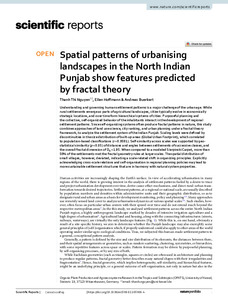| dc.date.accessioned | 2022-11-09T09:26:04Z | |
| dc.date.available | 2022-11-09T09:26:04Z | |
| dc.date.issued | 2022-02-02 | |
| dc.identifier | doi:10.17170/kobra-202211097086 | |
| dc.identifier.uri | http://hdl.handle.net/123456789/14239 | |
| dc.description.sponsorship | Gefördert durch den Publikationsfonds der Universität Kassel | ger |
| dc.language.iso | eng | |
| dc.rights | Namensnennung 4.0 International | * |
| dc.rights.uri | http://creativecommons.org/licenses/by/4.0/ | * |
| dc.subject.ddc | 300 | |
| dc.subject.ddc | 630 | |
| dc.title | Spatial patterns of urbanising landscapes in the North Indian Punjab show features predicted by fractal theory | eng |
| dc.type | Aufsatz | |
| dcterms.abstract | Understanding and governing human settlement patterns is a major challenge of the urban age. While rural settlements emerge as parts of agricultural landscapes, cities typically evolve in economically strategic locations, and over time form hierarchical systems of cities. Purposeful planning and the collective, self-organized behavior of the inhabitants interact in the development of regional settlement patterns. Since self-organizing systems often produce fractal patterns in nature, this study combines approaches of land use science, city ranking, and urban planning under a fractal theory framework, to analyze the settlement system of the Indian Punjab. Scaling levels were defined by discontinuities in the size distribution of built-up areas (Global Urban Footprint), which correlated to population-based classifications (r = 0.9591). Self-similarity across scales was supported by geo-statistical similarity (p < 0.05) of distances and angles between settlements of successive classes, and the overall fractal dimension of DB = 1.95. When compared to a modeled Sierpinski Carpet, more than 50% of the settlements met the fractal geometry rules at larger scales. The spatial distribution of small villages, however, deviated, indicating a scale-related shift in organizing principles. Explicitly acknowledging cross-scale relations and self-organisation in regional planning policies may lead to more sustainable settlement structures that are in harmony with natural system properties. | eng |
| dcterms.accessRights | open access | |
| dcterms.creator | Nguyen, Thanh Thi | |
| dcterms.creator | Hoffmann, Ellen M. | |
| dcterms.creator | Buerkert, Andreas | |
| dc.relation.doi | doi:10.1038/s41598-022-05906-4 | |
| dc.subject.swd | Punjab (Indien) | ger |
| dc.subject.swd | Verstädterung | ger |
| dc.subject.swd | Siedlung | ger |
| dc.subject.swd | Landschaft | ger |
| dc.subject.swd | Nachhaltigkeit | ger |
| dc.subject.swd | Fraktalgeometrie | ger |
| dc.subject.swd | Stadtentwicklung | ger |
| dc.subject.swd | Stadtplanung | ger |
| dc.subject.swd | Sierpiński-Teppich | ger |
| dc.type.version | publishedVersion | |
| dcterms.source.identifier | eissn:2045-2322 | |
| dcterms.source.journal | Scientific Reports | eng |
| dcterms.source.volume | Volume 12 | |
| kup.iskup | false | |
| dcterms.source.articlenumber | 1819 | |


